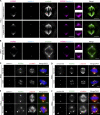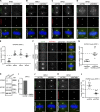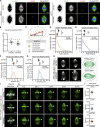WDR62 localizes katanin at spindle poles to ensure synchronous chromosome segregation
- PMID: 34137788
- PMCID: PMC8240857
- DOI: 10.1083/jcb.202007171
WDR62 localizes katanin at spindle poles to ensure synchronous chromosome segregation
Abstract
Mutations in the WDR62 gene cause primary microcephaly, a pathological condition often associated with defective cell division that results in severe brain developmental defects. The precise function and localization of WDR62 within the mitotic spindle is, however, still under debate, as it has been proposed to act either at centrosomes or on the mitotic spindle. Here we explored the cellular functions of WDR62 in human epithelial cell lines using both short-term siRNA protein depletions and long-term CRISPR/Cas9 gene knockouts. We demonstrate that WDR62 localizes at spindle poles, promoting the recruitment of the microtubule-severing enzyme katanin. Depletion or loss of WDR62 stabilizes spindle microtubules due to insufficient microtubule minus-end depolymerization but does not affect plus-end microtubule dynamics. During chromosome segregation, WDR62 and katanin promote efficient poleward microtubule flux and favor the synchronicity of poleward movements in anaphase to prevent lagging chromosomes. We speculate that these lagging chromosomes might be linked to developmental defects in primary microcephaly.
© 2021 Guerreiro et al.
Figures












Similar articles
-
WDR62 regulates spindle dynamics as an adaptor protein between TPX2/Aurora A and katanin.J Cell Biol. 2021 Aug 2;220(8):e202007167. doi: 10.1083/jcb.202007167. Epub 2021 Jun 17. J Cell Biol. 2021. PMID: 34137789 Free PMC article.
-
Microtubule minus-end regulation at spindle poles by an ASPM-katanin complex.Nat Cell Biol. 2017 May;19(5):480-492. doi: 10.1038/ncb3511. Epub 2017 Apr 24. Nat Cell Biol. 2017. PMID: 28436967 Free PMC article.
-
Aurora A phosphorylation of WD40-repeat protein 62 in mitotic spindle regulation.Cell Cycle. 2016;15(3):413-24. doi: 10.1080/15384101.2015.1127472. Cell Cycle. 2016. PMID: 26713495 Free PMC article.
-
The Multiple Mitotic Roles of the ASPM Orthologous Proteins: Insight into the Etiology of ASPM-Dependent Microcephaly.Cells. 2023 Mar 16;12(6):922. doi: 10.3390/cells12060922. Cells. 2023. PMID: 36980263 Free PMC article. Review.
-
Mitotic motors and chromosome segregation: the mechanism of anaphase B.Biochem Soc Trans. 2011 Oct;39(5):1149-53. doi: 10.1042/BST0391149. Biochem Soc Trans. 2011. PMID: 21936780 Review.
Cited by
-
Cell state-specific cytoplasmic density controls spindle architecture and scaling.Nat Cell Biol. 2025 Jun;27(6):959-971. doi: 10.1038/s41556-025-01678-x. Epub 2025 Jun 13. Nat Cell Biol. 2025. PMID: 40514430 Free PMC article.
-
The minus-end depolymerase KIF2A drives flux-like treadmilling of γTuRC-uncapped microtubules.J Cell Biol. 2023 Oct 2;222(10):e202304020. doi: 10.1083/jcb.202304020. Epub 2023 Aug 24. J Cell Biol. 2023. PMID: 37615667 Free PMC article.
-
WDR62 regulates spindle dynamics as an adaptor protein between TPX2/Aurora A and katanin.J Cell Biol. 2021 Aug 2;220(8):e202007167. doi: 10.1083/jcb.202007167. Epub 2021 Jun 17. J Cell Biol. 2021. PMID: 34137789 Free PMC article.
-
Time is of the essence: the molecular mechanisms of primary microcephaly.Genes Dev. 2021 Dec 1;35(23-24):1551-1578. doi: 10.1101/gad.348866.121. Genes Dev. 2021. PMID: 34862179 Free PMC article. Review.
-
Centrosome age breaks spindle size symmetry even in cells thought to divide symmetrically.J Cell Biol. 2024 Aug 5;223(8):e202311153. doi: 10.1083/jcb.202311153. Epub 2024 Jul 16. J Cell Biol. 2024. PMID: 39012627 Free PMC article.
References
Publication types
MeSH terms
Substances
LinkOut - more resources
Full Text Sources
Molecular Biology Databases

